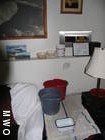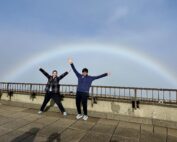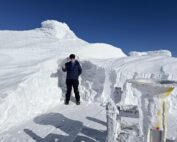Challenges on Mount Washington
2010-09-30 22:35:16.000 – Brian Clark, Observer and Meteorologist
Water, water, everywhere
While I was in the kitchen making lunch this afternoon, I had an interesting conversation with fellow observer Mike Finnegan and our volunteer for the week, Matt Stearns. Matt brought up a topic from our weekly Wednesday shift change meeting from the previous day, and mentioned that although probably mundane to us, he found the problems and challenges that we face while working in this setting very intriguing. My response was something along the lines of, ‘They’re interesting for us at first, but often they quickly turn to nuisances and frustrations when they recur over and over again’.
Now it doesn’t take long working on the summit to realize that we face some very unique challenges in completing our mission as a non-profit scientific, education, and research organization. Although winter tends to bring these in greater frequency, every season has its problems.
Take today for example.
If you live anywhere on the east coast, you already know that saying it rained today would be an understatement. Mount Washington was certainly no exception with almost 1.5 inches of rain measured as of the writing of this comment. All that water, coupled with ‘moderate’ winds (40-60 mph) forces water through the smallest of cracks in the building. Considering that the Sherman Adams Building is now almost exactly 30 years old, those cracks and crevices are quite numerous. Of course, we have tried numerous ways of keeping the water out: silicone sealant, foam weather seal, etc. Sometimes it works, most of the time, it doesn’t. In the end, placing buckets in strategic locations is often the only real ‘solution’.
All this water not only makes a mess, but also makes things that should seem like simple tasks, very complex to nearly impossible. For example, painting the concrete floor in the Cold Room, one of the levels of our tower. This summer we have made a concerted effort to clean and paint the tower, and this floor is one of the last things to complete in that effort. On advice from a paint expert, we purchased an epoxy paint that would typically be used to paint something like a garage floor. The problem: it turns out this paint needs about one week of dry conditions to really cure properly, and then be resistant to the effects of water. If you know anything about Mount Washington, you know that getting even just two or three consecutive days of dry weather is very, very rare. So unfortunately, after just a week and a half, some of the paint on the Cold Room floor is already starting to peel up because water pools on the floor. This is not a new problem, and definitely falls under the category of challenges that just get more frustrating as time goes on.
In the end though, this facet of working on Mount Washington is one of the reasons that I enjoy working here. Just when I think you’ve figured everything out, something new comes along, keeping me on my toes and always keeping me challenged. Luckily for me, this is not only something I look for in a job, but also in life in general.
Brian Clark, Observer and Meteorologist
Supporter Spotlight: Colleen Gendron
Supporter Spotlight: Colleen 'Coco' Gendron By Wendy Almeida In the 1970s, Colleen 'Coco' Gendron was introduced to hiking by a close friend’s father, an avid hiker and Appalachian Mountain Club instructor, who shared stories of Mount
I Did Not Get Blown Off, I Persisted
I Did Not Get Blown Off, I Persisted By Alyssa Bélanger Hello again! To write this farewell blog summarizing my three months on the remote summit of Mount Washington, I decided to take a
An Experience Worth 1,000 More
An Experience Worth 1,000 More By Mitchell Tsokatos Me and the summit sign once winter really got going. Taken 11/2/25. Unfortunately, my time on Mount Washington as an intern has come to





